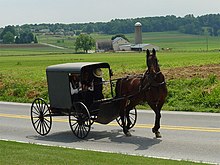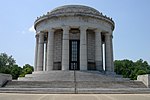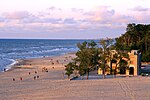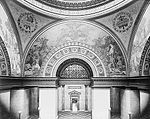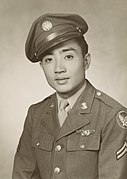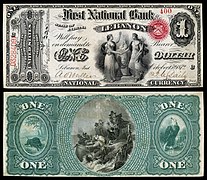Portal:Indiana
Various indigenous peoples inhabited what would become Indiana for thousands of years, some of whom the U.S. government expelled between 1800 and 1836. Indiana received its name because the state was largely possessed by native tribes even after it was granted statehood. Since then, settlement patterns in Indiana have reflected regional cultural segmentation present in the Eastern United States; the state's northernmost tier was settled primarily by people from New England and New York, Central Indiana by migrants from the Mid-Atlantic states and adjacent Ohio, and Southern Indiana by settlers from the Upland South, particularly Kentucky and Tennessee.
Indiana has a diverse economy with a gross state product of $352.62 billion in 2021. It has several metropolitan areas with populations greater than 100,000 and a number of smaller cities and towns. Indiana is home to professional sports teams, including the NFL's Indianapolis Colts and the NBA's Indiana Pacers. The state also hosts several notable competitive events, such as the Indianapolis 500, held at Indianapolis Motor Speedway. (Full article...)
The Amish (/ˈɑːmɪʃ/; Pennsylvania German: Amisch; German: Amische), formally the Old Order Amish, are an ethnoreligious group with Swiss German and Alsatian origins. Consisting of several Anabaptist Christian church fellowships, they are closely related to Mennonites, a separate Anabaptist denomination. The Amish are known for simple living, plain dress, Christian pacifism, and slowness to adopt many conveniences of modern technology, with a view neither to interrupt family time, nor replace face-to-face conversations whenever possible, and a view to maintain self-sufficiency. The Amish value rural life, manual labor, humility and Gelassenheit (submission to God's will). As they rarely accept converts, maintain a separate language and culture from surrounding populations, and hold their faith in common, they have been described by scholars as an ethnoreligious group, combining features of an ethnicity and a denomination.
The Amish church began with a schism in Switzerland within a group of Swiss and Alsatian Mennonite Anabaptists in 1693 led by Jakob Ammann. Those who followed Ammann became known as Amish. In the second half of the 19th century, the Amish divided into Old Order Amish and Amish Mennonites; the latter do not abstain from using motor cars, whereas the Old Order Amish retained much of their traditional culture. When people refer to the Amish today, they normally refer to the Old Order Amish, though there are other subgroups of Amish. In the early 18th century, many Amish and Mennonites immigrated to Pennsylvania for a variety of reasons. (Full article...)- ... that LGBT rights activist Kit Malone helped create the first transgender organized marching group in the Indianapolis Pride Parade's history?
- ... that after the Wolverines released their "Moose" for his fifth season, he went on to win another Big Ten championship with the Hoosiers?
- ... that William N. Salin was twice decorated with the Sagamore of the Wabash?
- ... that three years prior to this month's massive plastics fire in Indiana, a court determined that the site was a fire hazard "unsafe to people and property"?
- ... that a woman hitchhiked from Indiana to Washington, D.C., to protest the sale of the radio station where she worked?
- ... that the Indy Bag Ladies, one of the oldest AIDS fundraising organizations, is a group of activist drag queens in Indianapolis who have raised more than $1 million for AIDS patients?

Thomas Riley Marshall (March 14, 1854 – June 1, 1925) was an American politician who served as the 28th vice president of the United States from 1913 to 1921 under President Woodrow Wilson. A prominent lawyer in Indiana, he became an active and well known member of the Democratic Party by stumping across the state for other candidates and organizing party rallies that later helped him win election as the 27th governor of Indiana. In office, he attempted to implement changes from his progressive agenda to the Constitution of Indiana, but his efforts proved controversial and were blocked by the Indiana Supreme Court.
Marshall's popularity as Indiana governor, and the state's status as a critical swing state, helped him secure the Democratic vice presidential nomination on a ticket with Wilson in 1912 and win the subsequent general election. An ideological rift developed between the two men during their first term leading Wilson to limit Marshall's influence in the administration. Marshall's brand of humor caused Wilson to move his office away from the White House, further isolating him. Marshall was targeted in an assassination attempt in 1915 for supporting intervention in World War I. During Marshall's second term he delivered morale-boosting speeches across the nation during the war and became the first U.S. vice president to hold cabinet meetings, which he did while Wilson was in Europe during peace negotiations. As he was president of the United States Senate, a small number of anti-war Senators kept it deadlocked by refusing to end debate. To enable critical wartime legislation to be passed, Marshall had the body adopt its first procedural rule allowing filibusters to be ended by a two-thirds majority vote—a variation of this rule remains in effect. (Full article...)- Economy: AM General - ATA Airlines - Casinos - Cummins - Delta - ITT - JayC - Lilly - Limestone - Manufacturing - NiSource - Shoe Carnival - Simon Property Group - Soybeans - Studebaker - Vectren - WellPoint
- Geography: Caves - Lakes - Rivers - State forests - Watersheds
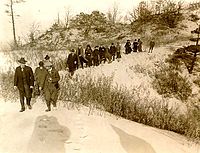 |
| This is a list of recognized content, updated weekly by JL-Bot (talk · contribs) (typically on Saturdays). There is no need to edit the list yourself. If an article is missing from the list, make sure it is tagged (e.g. {{WikiProject Indiana}}) or categorized correctly and wait for the next update. See WP:RECOG for configuration options. |
 |
Here are some tasks awaiting attention:
|
The following Wikimedia Foundation sister projects provide more on this subject:
-
Commons
Free media repository -
Wikibooks
Free textbooks and manuals -
Wikidata
Free knowledge base -
Wikinews
Free-content news -
Wikiquote
Collection of quotations -
Wikisource
Free-content library -
Wikiversity
Free learning tools -
Wikivoyage
Free travel guide -
Wiktionary
Dictionary and thesaurus

